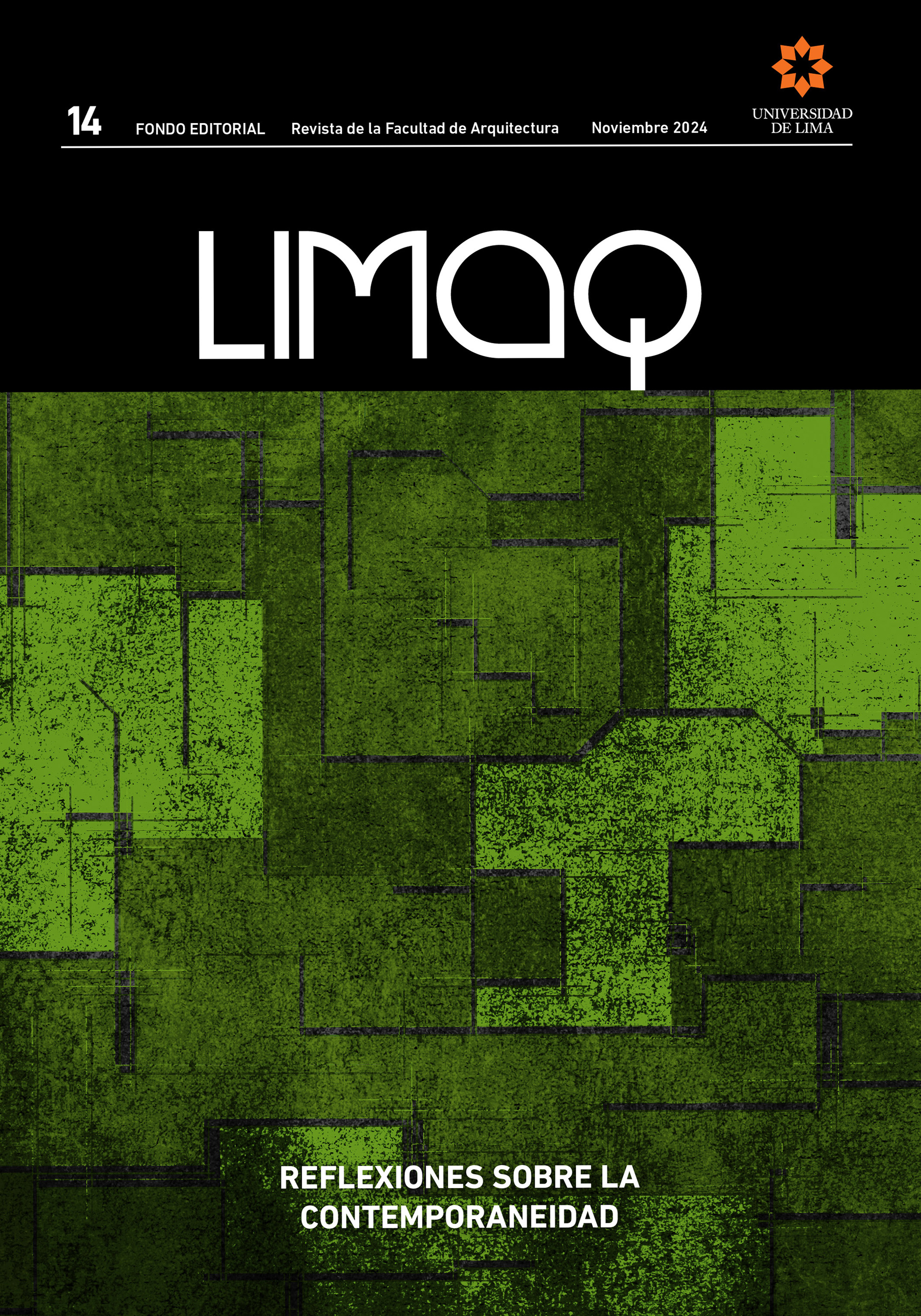Technified bajareque. Evaluation of embodied water compared to conventional building
DOI:
https://doi.org/10.26439/limaq2024.n14.6880Keywords:
embodied water, water stress, sustainable construction, wattle and daubAbstract
One of the great challenges facing humanity is the conservation of natural resources as valuable as water. However, overexploitation motivated by intense industrialization processes compromises water security for future generations. Because the construction industry is one of the largest consumers of water, it is necessary to design construction systems that contribute to water sustainability. The objective of this work is to develop a comparative analysis between a conventional construction system and an mixed one called Bajareque Tecnificado, which uses earth frameworks, built at the Autonomous University of Coahuila, Torreón Unit, Mexico, based on a quantitative method that evaluates the embodied water per component of each construction system. The results indicate that the Bajareque Tecnificado system reduces total water consumption by up to 25 % compared to conventional buildings.
Downloads
References
Banco Mundial. (2020). Extracción anual total de agua dulce.
Bardhan, S., & Choudhuri, I. (2016). Studies on virtual water content of urban buildings in India. Indian Journal of Science and Technology, 9(6), 1-8. https://indjst.org/articles/studies-on-virtual-water-content-of-urban-buildings-in-india
CEMEX. (2005). Manual del constructor. Talleres de Proceso Gráfico.
Crawford, R. (2022, 1 de diciembre). Embodied water in construction. Australian Institute of Architecs. https://acumen.architecture.com.au/environment/water/embodied-water-in-construction/
Crawford, R., & Pullen, S. (2011). Life cycle water analysis of a residential building and its occupants. Building Research & Information, 39(6), 589-602. https://doi.org/10.1080/09613218.2011.584212
Crawford, R., & Treloar, G. (2005). An assessment of the energy and water embodied in commercial building construction. En Australian Life Cycle Assessment Conference (pp. 1-10). https://dro.deakin.edu.au/articles/conference_contribution/An_assessment_of_the_energy_and_water_embodied_in_commercial_building_construction/20548017
Crawford, R., & Treloar, G. (2010). Database of embodied energy and water values for materials. University of Melbourne.
Gerbens-Leenes, P., Hoekstra, A., & Bosman, R. (2018). The blue and grey water footprint of construction materials: Steel, cement and glass. Water Resources and Industry, 19, 1-12. https://www.sciencedirect.com/science/article/pii/S2212371717300458?via%3Dihub
González, A. J., & Guerrero, L. F. (2022). Bajareque tecnificado. Evaluación de energía incorporada y emisiones de CO2 en comparación con la edificación convencional: sistema constructivo alternativo para la vivienda rural de Torreón, México. Vivienda y Comunidades Sustentables, 11, 9-21. https://doi.org/10.32870/rvcs.v0i11.177
Guerrero, L. F. (2020). El uso de tierra modelada en la intervención de componentes constructivos de adobe. Intervención, 2(22), 131-187. https://doi.org/10.30763/Intervencion.236.v2n22.15.2020
Henneberg, A. (2014). Tres pasos para la recuperación de la arquitectura de tierra en el estado Zulia, Venezuela. En F. J. Sandoval & J. L. Sáinz (Coords.), Construcción con tierra. Investigación y documentación. XI CIATTI 2014. Congreso de Arquitectura de Tierra en Cuenca de Campos (pp. 235-242). https://www5.uva.es/grupotierra/publicaciones/digital/libro2015/024henneberg.pdf
Hoekstra, A., Chapagain, A., Aldaya, M., & Mekonnen, M. (2011). Manual de evaluación de la huella hídrica. https://www.waterfootprint.org/resources/TheWaterFootprintAssessmentManual_Spanish.pdf
Kibert, C. J. (2013). Sustainable construction: Green building design and delivery. Wiley.
Maddocks, A., Young, R. S., & Reig, P. (2015, 26 de agosto). Ranking the world’s most water-stressed countries in 2040. World Resources Institute. https://www.wri.org/insights/ranking-worlds-most-water-stressed-countries-2040
McCormark, C., Treloar, G., Palmowski, L., & Crawford, R. (2007). Modelling direct and indirect water requirements of construction. Building Research & Information, 35(2), 156-162. https://doi.org/10.1080/09613210601125383
Mekonnen, M., & Hoekstra, A. (2010). The green, blue and grey water footprint of crops and derived crop products. Volume 1: Main report. UNESCO-IHE. https://www.waterfootprint.org/resources/Report47-WaterFootprintCrops-Vol1.pdf
Miller, S. A., Horvath, A., & Monteiro, P. J. M. (2018). Impacts of booming concrete production on water resources worldwide. Nature Sustainability, 1, 69-76. https://doi.org/10.1038/s41893-017-0009-5
Neves, C., & Borges, O. (Orgs.). (2011). Técnicas de construcción con tierra. PROTERRA. https://redproterra.org/wp-content/uploads/2020/05/4a_PP-Tecnicas-de-construccion-con-tierra_2011.pdf
ONU-AGUA (2019). Informe de políticas de ONU-AGUA sobre el cambio climático y el agua. https://www.unwater.org/sites/default/files/app/uploads/2019/12/UN-Water_PolicyBrief_Water_Climate-Change_ES.pdf
Satthya, A. (2023). A review of water footprint in building construction. Journal of Research in Infrastructure Designing, 6(1), 20-24. https://zenodo.org/records/7820336
Smakhtin, V., Revenga, C., & Döll, P. (2004). Taking into account environmental water requirements in global-scale water resources assessments. https://www.iwmi.cgiar.org/assessment/files/pdf/publications/ResearchReports/CARR2.pdf
Treloar, G., McCormack, M., Palmowski, L., & Fay, R. (2004). Embodied water of construction. The Environment Design Guide, 1-8. https://www.jstor.org/stable/26149125
UN-Water. (2019). Informe mundial de las Naciones Unidas sobre el desarrollo de los recursos hídricos 2019. No dejar a nadie atrás. UNESCO. https://unesdoc.unesco.org/ark:/48223/pf0000367304
UN-Water. (2021). Informe mundial de las Naciones Unidas sobre el desarrollo de los recursos hídricos 2021. El valor del agua. UNESCO. https://unesdoc.unesco.org/ark:/48223/pf0000378890
UN-Water (2022). Informe mundial de las Naciones Unidas sobre el desarrollo de los recursos hídricos 2022. Aguas subterráneas, hacer visible el recurso invisible. UNESCO. https://unesdoc.unesco.org/ark:/48223/pf0000380726_spa



